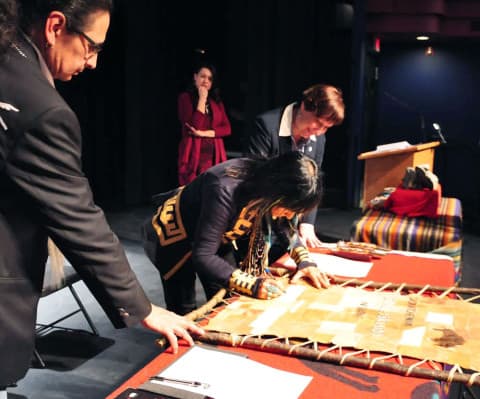TAYLOR BOROWETZ

Artist Buffy Sainte-Marie and U of S President Ilene Busch-Vishniac sign a memorandum of understanding to develop Aboriginal culture in Saskatchewan’s education system.
A partnership between the University of Saskatchewan and singer Buffy Sainte-Marie’s Cradleboard Project has formed to develop resources which represent Aboriginal culture in Saskatchewan’s education system.
The Saskatchewan Cradleboard Initiative is a collaboration for the development of kindergarten to Grade 8 science, technology, engineering and math curriculum resources that incorporates numerous cultures.
The partnership’s vision is to be “an evolving, living multi-media resource that reflects the diversity of perspectives and contributions of Saskatchewan’s Aboriginal Peoples, and encourages a positive self-identity for all learners, confidence with cross-cultural dialogue and the development of personal and social agency through scientific literacy.”
U of S President Ilene Busch-Vishniac stated in a press release that the SCI is a unique opportunity for Aboriginal education for both Saskatchewan and Canada.
“We are committed to being leaders in Aboriginal engagement, education and research, not only in Saskatchewan but also beyond the borders of our province throughout Canada,” Busch-Vishniac said.
U of S students and Aboriginal educators are developing the SCI resources and are promoting the inclusion of their own learning perspectives.
Sandra Bonny, project developer for the SCI, said that such an initiative is long overdue.
“I grew up in Saskatoon and learned very little about First Nations people, and certainly not in my science classroom,” Bonny said.
The idea for the partnership has been in the works since 2011, when the Society for Teaching and Learning in Higher Education conference was held at the U of S.
“We explored the potential of connecting experiential learning at the university level with a crippling resource deficit in the newly implemented kindergarten to Grade 8 science curriculum, specifically relating to the parallel presentation of western and Indigenous perspectives on science as a way of knowing and relating to the natural world.”
Saskatchewan curriculum mandates integrating Euro-Canadian and Indigenous perspectives in science classes. Bonny said the delivery of Indigenous perspectives has been weakened due to a lack of resources for teachers.
“The SCI aims to address that resource gap, which positions the integration of Aboriginal perspectives as a problem for many non-Aboriginal teachers by providing fun, authentic and rigorous resources to connect and celebrate learning across diverse ways of knowing in our province,” Bonny said.
The initiative hopes to dispel cultural myths and biases, replace misinformation and build confidence in multi-ethnic settings beyond the classroom. Teachers and university students will develop these additional resources to enhance existing curricula.
While supporting kindergarten to Grade 12 student engagement, Bonny said that U of S students will also benefit by being exposed to Aboriginal perspectives. Bonny hopes that implementing the work of university students will inspire younger children to consider post-secondary education, especially those who might not have otherwise.
Bonny said that underrepresented contributions and perspectives from Indigenous people — especially in the sciences and in a province that has a growing Aboriginal population like Saskatchewan — has created an imbalance.
“We are co-creating our future in this province and it is important to entrench, within all disciplines, multi-vocality and the richness of critical, cultural and social capacity this offers to students of all backgrounds,” she said.
The SCI is hoping to encourage communication and exchange within a culturally diverse province. With the immense importance of cultural relevancy, Bonny said that this initiative will create a more welcoming environment for all students in science, technology, engineering and math classrooms.
“Indigenous peoples have thrived in this province for thousands of years,” Bonny said. “And the depth of knowledge and connection to this place provide critical contributions to scientific literacy.”
—
Photo: Sandra Bonny